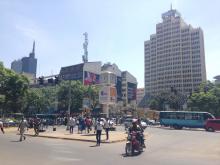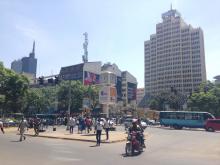Traffic jams in the Kenyan capital, Nairobi, are estimated to cost the country $360 million a year in terms of lost man-hours, fuel and pollution. According to Wilfred Oginga, an engineer with the Kenya Urban Roads Authority (KURA), the congestion has been exacerbated by poor regulation and enforcement of traffic rules, absence of adequate traffic management systems and poor utilisation of existing road facilities.
“Typical commute time for people going to work in Nairobi ranges from one hour to two hours for a 10 to 15km commute,” says Oginga, adding “there is also low uptake of technology in transport systems management and ineffective parking management system.”
Furthermore, Nairobi City is currently staring at a worsening traffic congestion crisis that has not been solved by interventions such as additional lanes, closure of some roundabouts and construction of missing links.
An integrated urban surveillance system comprising of security surveillance, traffic monitoring and management based on an IP platform, was installed in 2013 by Chinese specialist Nanjing Les Information Technologies. It won a competitive $5 million contract covering the supply of 51 cameras capable of carrying out ANPR at a range of 50m as well as new traffic lights.
Oginga says the Nanjing cameras, which are located at crime-prone spots and traffic light controlled junctions, provide live streaming of video from locations on the network and are connected to the network using fibre optic cable. This means the any of the 51 cameras can be viewed from any station on the network without limitation to allow the use of multiple monitoring stations for different users. It was designed to allow future compatibility with additional cameras with adaptable software when expansion was required.
“The system was expected to have capacity to capture vehicles violating traffic regulations through the number plate recognition cameras,” says Oginga.
However, the system developed operational challenges which Nairobi City County Governor Dr Evans Kidero blames on human interference.
“The system meant that traffic police were not required on the roads and we suspect the officers sabotaged it so that they can go back to the road to continue benefitting from bribes from rogue drivers,” said Kidero in a recent media interview on the failure of the system.
However, experts say the integrated urban surveillance system may have collapsed because of failure to appreciate the complexity of the project and incorporation of all stakeholders in Nairobi City’s transport sector.
“Some of the systems were installed but the staff mandated to operate them lacked the experience and skill required to do so, and maintenance was not carried out so they became dysfunctional,” says Paul Mboya, transport engineer specialising in East and Southern Africa for Nairobi-based Gauff Consultants.
A 2014 report on Nairobi’s integrated urban development master plan by Japan International Corporation found the impact of the City’s traffic surveillance system was minimal because they had been installed as separate components with no connection with other traffic systems.
‘A comprehensive policy development of ITS in Nairobi City does not exist’, it concluded.
According to Oginga, the existing Nairobi ITS system faces numerous ongoing challenges such as inadequate staffing, lack of internal technical capacity, lack of relevant ITS infrastructure, poor enforcement procedures and huge technology gaps across the transport sector.
Now, to ease vehicle congestion, reduce accidents and minimise security incidents Nairobi is to develop a modern intelligent traffic system. As lead project consultant, Gauff Consultants, has confirmed the commencement of the first phase of the largely World Bank financed project.
The project is part of the Nairobi Urban Transport Improvement Programme and is being promoted by KURA which manages, develops, rehabilitates and maintains all public roads in cities and municipalities. It is being financed with $13.4m loan from the bank.
The new Nairobi County Intelligent Transport System project entails installing traffic signal control and monitoring systems at 100 of the city’s 400 junctions.
“All the traffic signal control and monitoring system will be linked to a traffic monitoring centre that will be located in City as part of the new Nairobi ITS project,” says Mboya.
Once completed, the traffic monitoring centre’s staff will have real-time monitoring of pedestrians and vehicles to identify incidents and control of signal timings to regulate the traffic flow and, if necessary, prioritise detour routes to keep traffic moving around construction sites.
Mboya explains that the project is still at the design phase and implementation contracts are due to be awarded around end of February with the winning bidder implementing the project over the following two years. Only at the later stages will the component and system suppliers be confirmed.
To prevent a reoccurrence of past mistakes, key from stakeholders across the transport sector have come together to implement the new Nairobi City ITS project, which Mboya says is “an integrated and complex undertaking.”
These stakeholders include KURA, National Transport Safety Authority (NTSA), the Nairobi Metropolitan Area Transport Authority, Directorate of Nairobi Metropolitan Development, Traffic Police and Nairobi City County Government and Information and Communication Technology Authority among others.
According to Mboya: “Currently each agency works on its own and part of our project mandate is to facilitate the restructuring of their service delivery to make sure they talk to each other for an improved traffic flow and enhancement of safety.”
NTSA has already introduced the third licence stickers for all new and second hand motor vehicle registration as part of its transport integrated management system (TIMS) which will complement Nairobi’s new ITS system.
“The third licence sticker is placed on the vehicle’s windscreen and has discrete, overt and covert features of the motor vehicle registration and ownership,” says NTSA’s director general Francis Meja.
He says the stickers, which became effective in July “hold details such as the vehicle’s chassis number, make, registration number and other details.
“Security features protect the sticker against forgery and it is automatically destroyed when removed or tampered with,” Meja added.
On its website NTSA explains that the transport integrated management system “centralises road transport data and the portal offers intelligent traffic management by allowing tracking and monitoring of vehicles.”
An earlier attempt to roll-out smart number plates by NTSA was stalled by a court after bidders who lost out in the procurement process for hot stamping foils and blank number plates challenged the fairness of the process. According to Mboya, “Gauff Consultants will have an oversight and monitoring role for about 42 months within which period the performance of the system will be evaluated and any necessary changes made to optimise its performance.”
Managing traffic effectively requires quality data and that derived from the new ITS systems will not only be used to manage traffic in real time but also stored to build a history that highlights traffic trends within an area to inform decision making. As such it will be a more advanced than many of the more established system found in other large cities around the world.
Gauff Consultants, which is partnering with Germany’s Gauff Ingenieure-JBG and PB-Consult GmbH, UK’s WYG International and Germany’s Schlothauer & Wauer GmbH, is providing design for the project which will be safety audited by an independent road safety specialist. It will also produce the tender documents for the procurement of an EPC contractor.
“The project also involves software aspects such as training and helping with institutional framework reform and legal reforms,” says Mboya. He adds that Kenya’s current Traffic Act has gaps that need to be filled in order to enable the new road traffic control management system to conform.
Although the initial phase of the project is basically road transport management based, Mboya says the subsequent phases of new ITS system are expected to include integration with the envisaged Nairobi Bus Rapid Transit network. This network will form the backbone of Nairobi city’s transport and utilise the likes of the Uhuru Highway, Mombasa Road, Waiyaki Way, Ngong Road, Jogoo Road, Mbagathi Road, Outering Road and Thika Superhighway.
And this time around, nothing will be left to chance. “What Gauff Consultants will do in the new project is to help define an operation and maintenance regime that spells out who operates the systems and who maintains it and exactly what maintenance needs to be carried out,” he concludes.
Nairobi looks to ITS to ease travel problems
Shem Oirere looks at plans to tackle chronic congestion in the Kenyan capital.
Traffic jams in the Kenyan capital, Nairobi, are estimated to cost the country $360 million a year in terms of lost man-hours, fuel and pollution. According to Wilfred Oginga, an engineer with the Kenya Urban Roads Authority (KURA), the congestion has been exacerbated by poor regulation and enforcement of traffic rules, absence of adequate traffic management systems and poor utilisation of existing road facilities.
Shem Oirere looks at plans to tackle chronic congestion in the Kenyan capital.











